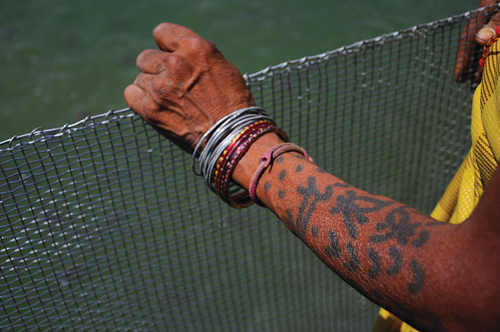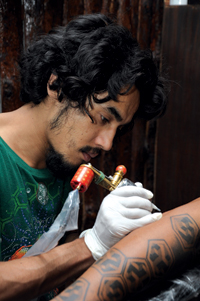With a tattoo convention called Nepal Inked just around the corner, a once thiriving part of Nepali culture is making a steady comeback. For tattoo enthusiasts, it was never gone.
At the age of 19, I declared to my dad that I wanted a tattoo when I turned 21. He gave me a disapproving look. When he saw that I was serious about it, he said no. He told me that I could have everything but a tattoo. For him, it was a western influence on me after seeing my favorite football player inking his body. But then on the other hand as a child, I remember seeing my late great-grandmother having the name of a deity (Krishna) tattooed on her hand. I decide to dig deeper; I thought of tattoo culture as something new in Nepal, an influence of the West and modernization. Little did I know that tattoos are actually an indigenous, cultural phenomenon and are prevalent amongst Nepali tribal communities.

TATTOO TRIBES
Tattoo culture is predominantly widespread among the Newar and Tharu communities of Nepal and also amongst Gurungs and Magars. Popular among the women of those communities, Lha: Choegu as it is called in Nepal Bhasa, was done during melas (carnivals) and jaatras (festivals) ) like Rato Machindranath Jaatra in Patan by artists from India. During those times, many men and women would flock around these artists to get inked. While the Syashyas of the Newar community had their hands inked, various designs and patterns are stil seen on the legs, right above the ankles, of Jyapu women.
According to Satya Mohan Joshi, Jyapunis (female members of the Jyapu community) usually made their permanent and single colored tattoos themselves since their designs are usually large and it would take time to complete.
“The community would usually have one female artist as an expert in tattoos, who must have a wonderful sense of memory,” said Mr Joshi. Come to think of it, its quite true, for these women would have needed to memorize the exact pattern they had to translate onto their bodies. To produce color, these artists would mix coal and the milk from certain plants.
Women in the Gurung and Magar community would use goat’s milk, coal or leaves along with either nilkanda or needles. These tattoos were usually done on the face, near the lips, with designs such as moons and stars, mostly for beautifying purposes. However, the culture is less prevalent among these communities than its southern counterparts.
For Tharus, tattoos or ‘godna’, are found predominantly among the community’s women on their hands, limbs, legs and chest. The ‘tattoo artists’ in their community are usually older women called ‘tikaniya’. In most households during the old days, Tharu women were not allowed to get married unless they had some form of ink on them. Because usually they engage in this around March or spring season, and the designs are mostly inspired by natural elements. For the ink, the artist would gather the soot from a mustard lamp whereas cow dung and mustard oil would be used as natural ointment to prepare the skin beforehand.
 A GENERATION GAP
A GENERATION GAP
Although the inking process was popular till our grandparents’ time, it seemed to have slowly lost its original charm sometime in the 70s in Nepal. Various skin diseases resulting from tattoos or unsafe processes practised during melas might be one cause of its reduced popularity amongst Newar culture. For the Tharu community, the fact that their tattooing ways were quiet too painful and gruesome might have helped lose part of its charm.
“It probably also happened because drug abusers and hooligans getting inked more,” said Mohan Gurung, one of Nepal’s most famous tattoo artists. During those times, people who were into drugs used to get inked as sign of rebellion against the norm of the society. Gurung remembers that although the society never questioned our grandparents who had tattoo, had started to look down upon those youths who had one too. Gurung’s tattoo studio in Thamel is simply named Mohan’s Tattoo Inn; their studio in Pokhara opened in 2000. “Thankfully, the art form is gaining its respect and admiration once again,” said Mr Gurung, indicating the recent craze for gettings tattoo among young Nepalis. Commercially, the modern form of tattoos is said to have been introduced in Nepal by the late Babu Raja Pradhan of Thamel Tattoo Studio, Nepal’s first tattoo studio, back in 1997.
“I never intended to get into this professionally,” says Mr Gurung, laughing when asked how this ancient art form got commercialized. “Personally, I wasn’t interested because at that time people only wanted to get symbols and names of gods inked.” The public kind of looked down upon tattoo enthusiasts during the start; mostly credited to the shady reputation of hippies and also rock music fans and their appreciation of tattoos. This is no longer the case. Things have started turning around with more people realizing that tattoos are an art form, a way to express oneself. Because of this change in perception, while a few tattoo studios were struggling to stay open before, today new studios are mushrooming all around Kathmandu and in other urban centers of the country.
THE EVOLUTION OF THE ART
Along with the change of people’s perception toward tattoos, the designs have also undergone distinct transformations. Mr Gurung shared that while designs like skulls, sailor motifs, tribal symbols and religious symbols were popular in the beginning, now along with oriental designs, artwork is also gaining popularity. Today, its not unusual to find clients coming in with their own designs. For Tattoo studios and artists too, its more about custom designs than repeating dated designs. The single-color tattoos that used to adorn people’s legs and hands are now mostly colorful, with clients getting increasingly interested in getting tattoos on more parts of the body; some even go for a full body suit. With the Internet and TV as media for highlighting various tattoo designs and patterns at an international level, tattoo studios and tattoo artists around the city are slowly going back to their roots, inking designs on flesh that stand out from designs from the rest of the world.
At the same time, to bridge the gap between tattoo artists and the clients as well as to help artists in the country and abroad, share their experience and learn from each other, tattoo conventions have been taking place for the last few years. “Conventions are necessary as it helps us to grow and be better at what we love the most.” shared Gurung, who is excited about taking part in the upcoming tattoo convention “Nepal Inked: Tattoo and Lifestyle Convention” that’s going to take place on 18th of October, 2013 in Bhrikuti Mandap.
According to Nijal Munankarmi, of Kgarira.com (one of the organizers), Nepal Inked aims to promote alternate lifestyle in Nepal. The event is to bring out the tattoo artists and those interested in tattoo and change the perspective about tattooing to the current generation. Although this is the first step in the plan, the organizers are aiming to establish tattoo as an industry as well as means of attracting tourist as the price is cheaper in Nepal for the same quality compared to abroad.
It seems that although there was a generation gap in tattoo culture, it is slowly getting to revive in its original form minus the time consumption and pain. Nothing is known about the origin and the introduction of tattoo in Nepal but since then, it has become a part of our art, our heritage and our tradition of the society. Although there was almost a generation gap, tattoos are now in vogue again. The best part is that this trend is slowly reviving the lost art form and might as well help in creating another niche for the country.
Myths around Tattoo
Tattoo is the only items we can take with us after we die.
When we die, tattoo converts into gold and we can sell them to continue our journey.
Happening this October|
An international tattoo and lifestyle convention, Nepal Inked aims to cater locals especially art lovers and promote tattoo culture and lifestyle besides changing their perceptions. It also aims to provide platform for the tattoo artists from international and national level to showcase their work and learn from each other. The convention will also see car show, bike show/stunts, seminars, sculpture making competition, concerts and art shows besides tattoo display.










